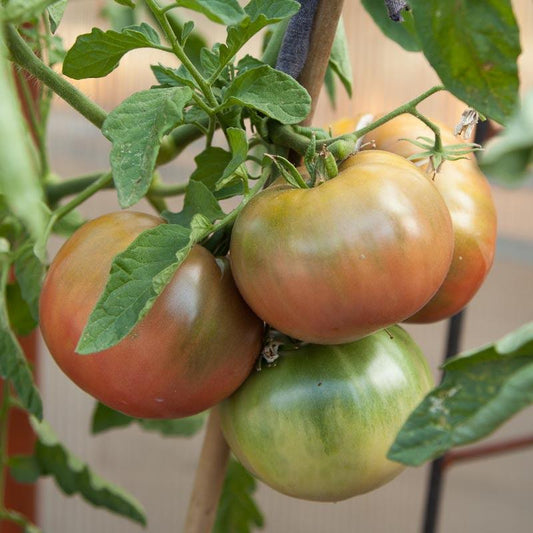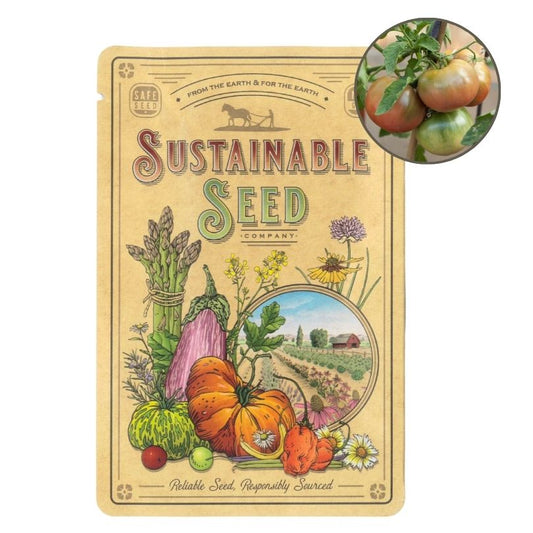Tomato Types

Slicing: Slicing tomatoes bear large fruits, commonly used as fresh or for sauce.
Cherry: Cherry Tomatoes are abundant, marble sized fruits for fresh use or drying.
Paste: Paste Tomatoes are thick fleshed often oblong for canning and drying.
Pear: Small abundant fruits of pear shape for fresh use or drying. Example is Midnight Pear.
Determinate
Typically only gets 3 to 5’ tall, depending on the variety. Suitable for container or short season growing. Most paste and early varieties are determinate. Heavy fruit set with a short harvest period.
Indeterminate
Requires support as it grows throughout the warm season providing a long harvest. Support indeterminate tomatoes with cages, stakes or trellis.
Growing Basics
Soil: Tomatoes prefer a soil pH between 5.5–7 and temperature of 80°F optimal for germination (will tolerate temperatures between 50-100). Soil should be well-draining with plenty of organic matter. Try growing tomatoes in some of our Peaceful Valley Organics Potting Soil; it is an excellent, organic all-around mix.
Air Temperatures: Tomatoes are considered a tender annual therefore set out transplants when days are consistently above 55°F.
Seed longevity: If properly stored, the seeds should be viable for about 4 years.
Companion Planting:
- Incompatibility — brassicas, corn, potatoes, kale, fennel
- Companions — basil, borage, chive, garlic, nasturtiums, marigolds
Water Requirements: Water needs to be consistent and moderate to high during growth, but lower during harvest period. Mulches can be used to retain moisture. Red mulching film has been shown to increase production as well as help to retain moisture.
Fertilization: Address amendments prior to transplanting into garden, supplementing per product label. Do not add excess nitrogen as this can lead to big leafy plants with little fruit.
Planting & Growing

Due to its tender nature, tomatoes should be sown indoors or two weeks after last frost if direct sown.
Sowing: Indoors 6–8 weeks before transplanting outdoors. Plant ¼–½” deep in dampened soilless mix (Quickroot) to prevent damping off. For best results, use heat mats and a grow lamp placed directly above or place in a sunny south facing window (they may become leggy, but can be planted deeply in garden). Keep seedbed consistently moist.
After first true set of leaves have formed, feed with half dilution of liquid fish and liquid kelp every 14 days. Allow surface to dry out slightly between watering.
Transplanting: Harden off transplants for 7–10 days before planting outdoors. Transplant out when night time temperatures are above 45°F and danger of frost has past. Placing out too early and exposing to cold temperatures can lead to cat facing or stunted growth. Best to plant outdoors in the cooler times of the day to decrease transplant shock.
Work soil well before planting and amend according to soil analysis or add a balanced fertilizer according to the label. If soil is too acidic or prone to blossom end rot, add calcium as well.
Space plants about 3’ apart to provide good air circulation. Plant tomato transplants deep, at least 2” deeper than original soil surface. Leggy plants can be buried deeper, leaving top leaves above the soil. This will result in a larger root system, as roots will develop along the buried stem. Water well after planting and apply a layer of mulch to conserve moisture and keep weeds down.
As plants grow, stake or trellis or surround with a cage. Prune suckers on indeterminate varieties to improve air circulation and decrease size of the plant.
Harvesting
Harvest as soon as fruits ripen to appropriate color while skins are firm. Fruit will easily separate from stem when ripe. (Removing older, split or malformed fruits will assist in setting of new blossoms.)
Store ripe fruit out of sunlight at room temperature and not in the refrigerator. Stored stem side down in a single layer if they are harvested before completely ripe. Late season green tomatoes can be stored in this way but enclosed in a paper bag or in a cardboard box.
Common Pests & Diseases

Armyworms: Causes damage to leaves and fruit. Handpick them off, or use beneficial insects or organic pesticides labeled for armyworms.
Blossom End Rot: Cause blackened rotted end of fruit. Maintain consistent soil moisture, provide sufficient soil calcium and do not over fertilize with high nitrogen.
Colorado Potato Beetle: Visual symptoms are holes in leaves. Cover with Agribon AG15 floating row covers when young. Hand pick the beetles off. Use praying mantids, sticky traps, or organic pesticides labeled for Colorado potato beetles.
Early Blight: Spore borne so begin with new plants in a clean garden area. Water from below leaves and allow air circulation. Remove all damaged leaves as detected and dispose of away from garden surfaces. Practice crop rotation, dispose of diseased plant in the trash and use an organic fungicide labeled for early blight.
Hornworm: Leaves and small or large portions of fruits eaten. Use beneficial insects, or organic pesticides labeled for hornworms.
Leaf Hoppers: Leaves appear scorched and wilted. Use beneficial insects, sticky traps or organic pesticides labeled for leaf hoppers.
Leaf Miners: Tunnels and trails across leaves. Use beneficial insects, sticky traps, or organic pesticides labeled for leaf miners.
Stink Bugs: Can cause cloudy spot (yellow discoloration on ripe fruit). Hand pick them off or use beneficial insects, sticky traps, or organic pesticides labeled for stink bugs.
Whiteflies: Usually found on the underside of leaves. Control by strong spray of water, beneficial insects, or organic pesticides labeled for whiteflies.
Pest Control – IPM
Integrated Pest Management (IPM) is an effective and environmentally sensitive approach to pest management that starts with the least invasive or impactful control methods and considers the use of chemical controls as the last step. For more information watch our Integrated Pest Management video.
Important to practice good cultural controls for pest management of tomatoes. Cultural controls such as removing plants after harvest (to avoid leaving food for insects to continue to multiply on), practice crop rotation (i.e. do not plant crops in same family, in the same area for 3 years), use row covers such as Agribon AG15 (apply before insects arrive or to protect against birds when plants are young).
Common Questions
What are the most common gardener mistakes with tomatoes? Adding too much or not enough fertilizer. Too much nitrogen creates a big leafy plant with little fruit and sometimes other disease issues. Overhead watering can lead to diseases. Starting seed in overly wet medium causes damping off rapidly.
Why and how are tomato plants pruned? Only prune indeterminate varieties. Pruning allows the circulation of air and sunshine required for healthy plants as well as the formation of stronger roots and better fruits. Prune out suckers on nodes below the first flower, can leave suckers above fruit. Leaves prevent sun scald to forming fruits, so don’t over prune your plants.
How can I determine what disease or nutritional deficiency is affecting my plants? Tomatoes have a wide variety of fungal as well as nutritional or weather related issues that can occur throughout their growth season. Most are able to be remedied, if diagnosed. Look closely at the fruits and leaves (which should be medium to dark green, soft and fuzzy) for signs that are distinctively atypical. Look on your state or another state’s Cooperative Extension website for photos and descriptions that match the symptoms noted.
Why do my tomatoes fail to set fruit or blossoms fall off? Temperatures are outside the optimum. Night temperatures below 55°F or day temperatures over 90°F can cause improper fruiting. Excess nitrogen creates a bountiful canopy of leaves to the detriment of fruiting. Planting too closely does not allow adequate air circulation required for male and female pollination off same plant. (There is a 3 day window when blossoms are ripe for pollination. During that time manually assist by gently shaking the branches.)
Definitions
Heirloom: Heirloom seeds come from open-pollinated plants that pass on similar characteristics and traits from the parent plant to the next generation plant. Heirloom vegetables are old-time varieties generally which have been in production since before WWII, and have been saved and handed down through multiple generations.
Hybrid: A cross between two or more unrelated plant varieties. The two different varieties are cross bred, resulting in a seed that carries one or more favorable traits (increased yield, uniformity, color, disease resistance.) Hybrid seeds are not GMO, as they are manually cross-bred, not genetically modified in a lab. Hybrid seed is often sterile or does not reproduce true to the parent plant. Therefore, never save the seed from hybrids.
Open Pollinated: Generally refers to seeds that will “breed true”. When the plants of an open-pollinated variety self-pollinate, or are pollinated by another representative of the same variety, the resulting seeds will produce plants roughly identical to their parents. Genetic traits may differ only slightly due to variations created by local conditions.
GMO: Genetically Modified Organisms were genetically modified in a laboratory where DNA genes are extracted and mixed with other unrelated plants to improve characteristics. Saved seed will not always be viable and may be trademarked to prevent unauthorized use.
🍅 Explore More: Tomatoes & Italian Garden Staples – Grow, Cook, Enjoy
Ready to bring the bold, sun-ripened flavors of Italy to your backyard or kitchen? These hand-picked resources from GrowOrganic.com will deepen your understanding of how to grow and use tomatoes—plus their essential culinary companions like basil, garlic, and arugula—for a garden-to-table experience that celebrates authentic Italian cooking.
- 👩🌾 Cultivating a Slice of Italy: Growing Your Own Ingredients for Authentic Italian Cooking
Turn your garden into a personal Italian pantry. Learn how to grow key ingredients like tomatoes, basil, and peppers, and see how they shine in traditional dishes like Caprese salad and pesto.
- 🌿 Indoor Basil Gardening for Year-Round Harvests
Keep fresh basil on hand for pesto, sauces, and salads—indoors, all year long. Learn container setup, watering tips, and how to maximize flavor with regular harvesting. - 🌶️ Growing Peppers 101
From sweet Italian frying peppers to spicy companions, this guide covers how to start and care for peppers in any climate. - 🧄 How to Grow Garlic: A Growing Guide
Garlic is essential to Italian flavor. Discover how to plant, feed, and harvest flavorful varieties like ‘Music’ for sauces, pastas, and roasts. - 🥬 Year-Round Arugula: Indoor Growing Techniques
Grow zesty arugula indoors for salads and pastas with a bite. Great for container gardening and cool-season planting. - 🛠️ Tips & Tools for Your First Vegetable Garden
Starting fresh? Build your gardening foundation with this essential guide on soil prep, planting tools, and layout planning. - 🧪 Vegetable Gardening Myths – Busted
Think you need lots of space or perfect soil to grow tomatoes and herbs? This article separates fact from fiction so you can garden with confidence. - 🍧 Italian Cream Soda Recipe
Reward yourself after a day in the garden with a bubbly, creamy treat. Customize your Italian cream soda with seasonal fruits or garden-grown basil syrup. - 🌱 Shop Non-GMO & Organic Seeds
Plant your own Italian harvest with high-quality, non-GMO, organic seeds. Explore heirloom tomatoes, aromatic herbs, and flavorful greens—all selected for taste and performance.




